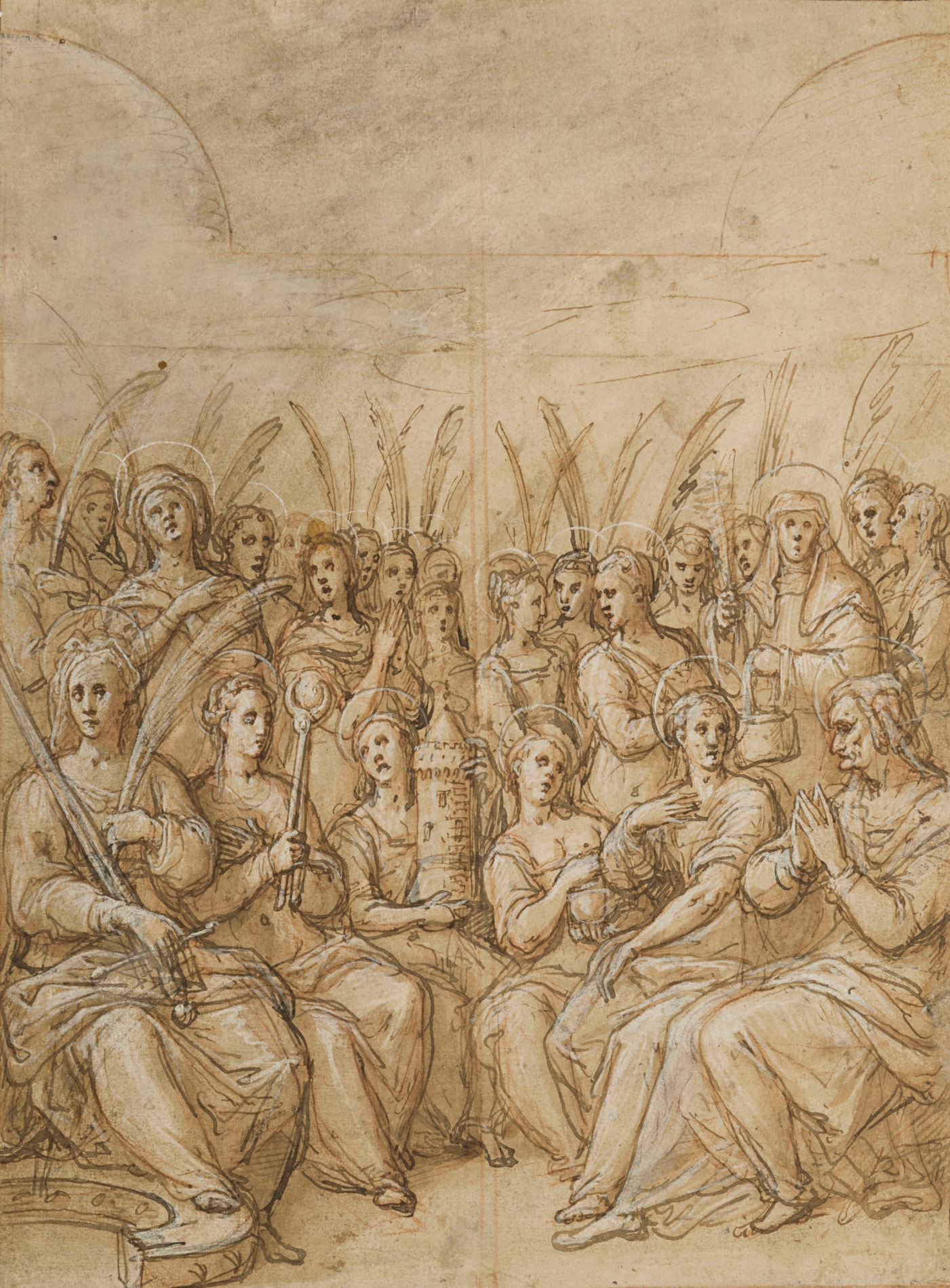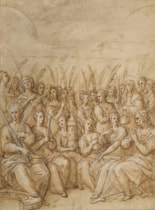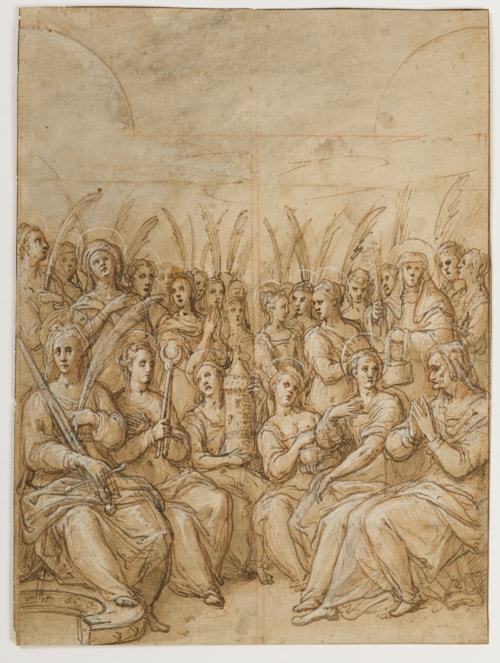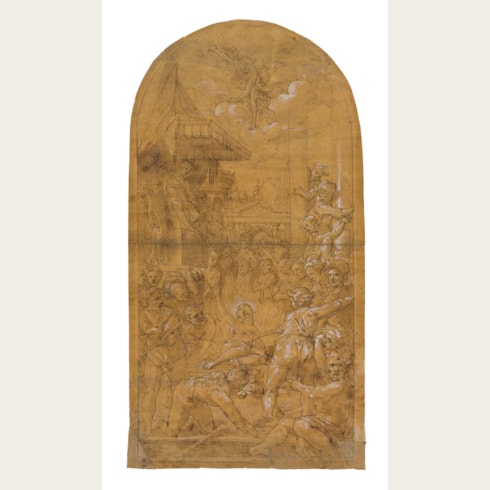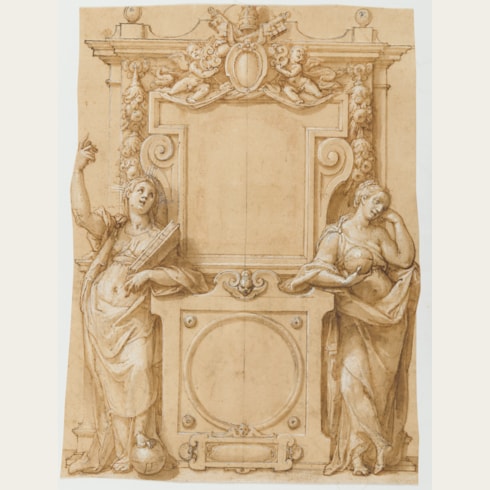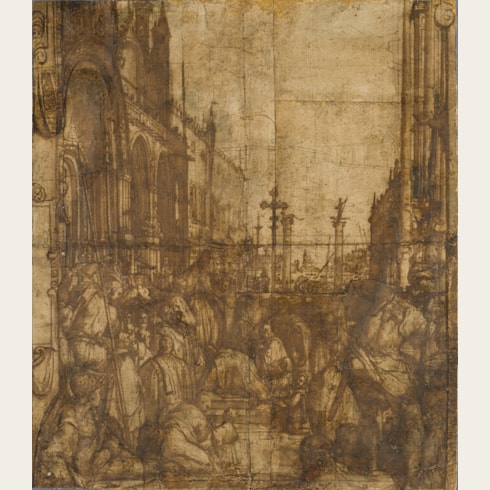Federico ZUCCARO
(Sant’Angelo in Vado c.1540/41 - Ancona 1609)
Design for the Outer Wings of an Altarpiece, with a Group of Virgin Martyrs and Other Female Saints
Numbered 659 on the verso.
342 x 254 mm. (13 1/2 x 10 in.)
Watermark: A coat of arms with text below.
ACQUIRED BY THE DETROIT INSTITUTE OF ARTS.
As John Gere had noted of this drawing, ‘Of the six seated saints in the front row, the three on the left can be identified from their attributes as Catherine of Alexandria, Agatha, and Barbara. The drawing cannot be connected with any known work by Federico. A group of female saints occurs in the northwest section of the cupola of the Duomo in Florence, but it occupies only one half of the width of the section and the figures are not grouped symmetrically as in the drawing.’ What may have been Zuccaro’s preparatory drawing for the outer wings of the same altarpiece or reliquary – a closely related sheet depicting A Group of Bishops, A Pope, A Cardinal and other Monastic Figures, of identical technique and dimensions to the present sheet – was on the Paris art market in 2004.
The present sheet was part of an album of seventy-three drawings, mainly by Taddeo and Federico Zuccaro, all of which had belonged to the eminent portrait painter and noted collector Sir Thomas Lawrence (1769-1830). An obsessive and passionate collector, Lawrence assembled one of the single greatest collections of Old Master drawings ever seen in England. Four years after Lawrence’s death, his collection was acquired by the art dealer and collector Samuel Woodburn (1753-1853), who was responsible for assembling the contents of the ‘Zuccaro album’. In 1860, several years after Woodburn’s death, many of the drawings from Lawrence’s collection that were still in his possession, including the ‘Zuccaro album’, were sold by his heirs at auction in London.
The ‘Zuccaro album’ was acquired at the Lawrence-Woodburn sale in 1860 by the bibliophile and collector Sir Thomas Phillipps (1792-1872), who bought several lots of drawings at the auction. Phillipps’s collection was inherited by his grandson Thomas Fitzroy Phillipps Fenwick (1856-1938), who began the dispersal of the collection of drawings, much of which was eventually acquired by the British Museum in 1946. The album of Zuccaro drawings was purchased from Phillipps Fenwick in 1930 by Dr. A. S. W. Rosenbach (1876-1952), an American dealer in rare books and manuscripts. While six drawings from the album were sold to the collector Janos Scholz and are now in the Pierpont Morgan Library in New York, the remainder of the album remained intact until it was acquired in 1978 by the British Rail Pension Fund and dispersed at auction twelve years later.
Federico Zuccaro was among the most well travelled artists of his day. Unlike Taddeo, he travelled throughout Italy, working in Venice, Florence, Orvieto, Bologna, Urbino, Pavia, Turin, Parma and Mantua, while also visiting France, the Netherlands and England between 1574 and 1575. On his return he received a commission to complete the decoration of the cupola of the Duomo in Florence, begun by Vasari and completed by Zuccaro between 1576 and 1579. The next year he was back in Rome, contributing to the decoration of the Cappella Paolina of the Vatican, before departing for Venice, where he worked between 1582 and 1584. He established a particular practice of making drawings after works of art that he saw on his journeys; a sort of visual travel diary that attests to a broad and wide-ranging interest in the different schools of painting in Italy. (As the Zuccaro scholar James Mundy has noted, ‘Federico was completely without prejudice in his omnivorous ingestion of the work of other artists, both past and present.’) In 1585 he was summoned by Philip II to Spain, where he painted eight canvases for the retablo mayor, or high altar, of the Basilica of San Lorenzo at El Escorial, as well as cloister frescoes in the attached monastery. Elected the first principe of the reorganized Accademia di San Luca in 1593, Zuccaro continued to receive important commissions late into his career. He built a fine palace for himself in Rome, now the home of the Biblioteca Hertziana. Near the end of his career he wrote an artistic treatise entitled L’idea de’ pittori, scultori et architetti, published in 1607.
A gifted draughtsman, Federico Zuccaro was much influenced by the drawings of his elder brother, particularly early in his long career. However, as Julian Brooks has noted, ‘Federico’s style was less dramatic than Taddeo’s, and he answered the demands of the Catholic Church for a clearer, more iconic art. His drawings and compositions are tidier than those of Taddeo, with less robust figures, a greater interest in decorative effects, and occasionally complex iconography.’ Furthermore, Federico’s peripatetic career, together with his inveterate copying of the work of other artists, exposed him to a wider range of artistic influences, which often found their way into his drawings and paintings. As Mundy has pointed out, ‘Whereas it would be fair to say that Taddeo’s style was invented in Rome, Federico’s was forged in an international crucible…The wide stylistic range of drawings might be expected but it still, at times, surprises the viewer.’
Provenance
Purchased after Lawrence’s death, together with the rest of his collection, by Samuel Woodburn, London, in 1834
His posthumous sale, London, Christie’s, 4-8 June 1860, part of an album of drawings sold as lot 1074 (‘ZUCCHERO (F. AND T.) – A most interesting Series of 20 Drawings, representing Incidents in the Life of Taddeo Zuccaro, drawn by his Brother Frederick; followed by 53 Specimens of their Works, in Bistre, Chalk, &c., consisting of Original Designs and Studies for some of their principal Pictures. Handsomely bound in red morocco. A superb and highly important Collection.’, bt. Phillips for £63 gns.)
Sir Thomas Phillipps, London and Thirlestaine House, Cheltenham, Gloucestershire
By descent to his grandson Thomas Fitzroy Phillipps Fenwick, Thirlestaine House, Cheltenham
The album acquired from him in 1930 by Abraham Simon Wolf Rosenbach, Philadelphia
The Philip H. and A. S. W. Rosenbach Foundation, Philadelphia
The album acquired from them in 1978 by the British Rail Pension Fund
Their sale, New York, Sotheby’s, 11 January 1990, the present sheet as lot 40
Anonymous sale, New York, Sotheby’s, 9 January 1996, lot 16
Gayfryrd Steinberg, New York.
Literature

